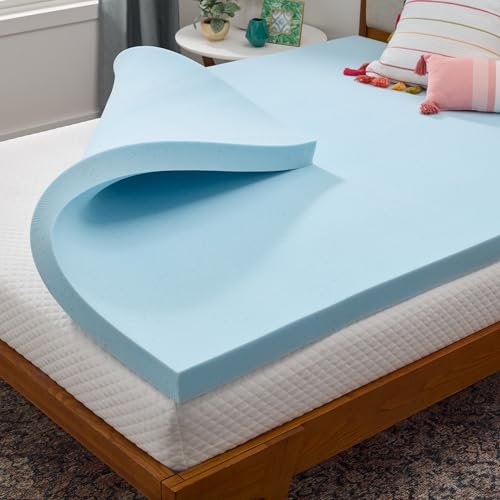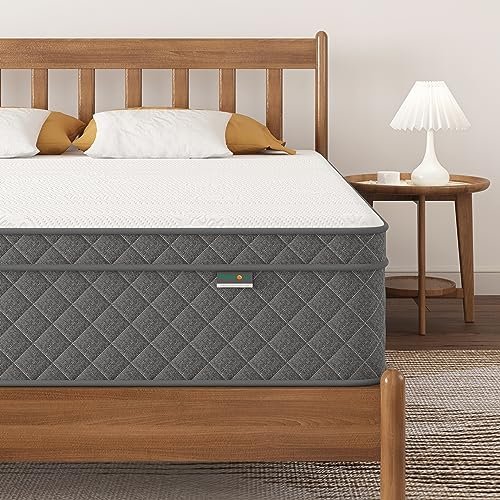
Finding the Perfect Density: Your Guide to Memory Foam Mattress Toppers
Recommended Product:
Are you looking to upgrade your sleep experience without breaking the bank or replacing your entire mattress? A memory foam mattress topper could be the perfect solution! But with so many options available, choosing the right density can feel overwhelming. This guide will walk you through everything you need to know to find the best density for your memory foam mattress topper, ensuring a comfortable and supportive night’s sleep.
Understanding Memory Foam Density
Memory foam density is measured in pounds per cubic foot (lb/ft³). This measurement indicates how much the foam weighs for a given volume. Higher density generally means a more durable and supportive topper, offering better pressure relief and longevity. However, it also often means a firmer feel. Lower density toppers are typically softer and more affordable, but they may not offer the same level of support and may wear out faster.
What Density is Right for You?
The ideal density depends entirely on your individual preferences and needs. Consider these factors:
-
Your Weight and Sleep Position: Heavier individuals generally benefit from higher-density toppers (4-5 lb/ft³ and above) for adequate support. Lighter individuals might find lower-density toppers (3-4 lb/ft³) more comfortable. Side sleepers often prefer softer toppers, while back and stomach sleepers might prefer firmer options.
-
Desired Level of Firmness: This is closely tied to density. Lower density equals softer feel, while higher density equals firmer feel. Consider your current mattress firmness and whether you want to add more softness or support. Do you prefer sinking in or sleeping on top of the mattress?
-
Budget: Higher-density toppers are generally more expensive. Set a realistic budget before you begin your search. Consider the long-term cost; a higher-density topper may last longer, saving you money in the long run.
Step-by-Step Guide to Choosing the Right Density:
Recommended Product:
-
Assess Your Current Mattress: Is it too firm, too soft, or just right? This helps determine whether you need a topper to add softness or support.
-
Consider Your Sleep Style: Are you a side, back, or stomach sleeper? This influences the level of pressure relief you require.
-
Determine Your Weight: Heavier individuals need denser foam to prevent bottoming out.
-
Set a Budget: This helps narrow down your options.
-
Research Density Ranges: Understand the relationship between density and firmness. Generally, 3-4 lb/ft³ is considered lower density (softer), while 4-5 lb/ft³ and above is considered higher density (firmer).
-
Read Reviews (but focus on density): While you shouldn’t rely solely on product reviews, paying attention to comments related to firmness and support can be helpful in gauging the feel of different density levels.
Tips for Success:
- Consider the Overall Thickness: Thicker toppers offer more cushioning but can change the overall height of your bed.
- Look for Quality Materials: Check for certifications like CertiPUR-US, which ensures the foam is made without harmful chemicals.
- Test the Topper (if possible): If you can test the topper in person before purchasing, do so! This will give you the best sense of its firmness and comfort.
Common Mistakes to Avoid:
- Choosing a density based solely on price: A cheaper, lower-density topper might not provide the support and longevity you need.
- Ignoring your sleep style and weight: This can lead to discomfort and inadequate support.
- Not considering the overall thickness: A topper that is too thick might make getting in and out of bed difficult.
By carefully considering your individual needs and following the steps outlined above, you can confidently choose the best density for your memory foam mattress topper and enjoy a more comfortable and restful night’s sleep. Remember, finding the perfect density is a personal journey, so don’t hesitate to experiment to find what works best for you!
Recommended Product:
FAQ
Q. What is the best density for a memory foam mattress topper?
A. There’s no single “best” density, as the ideal firmness depends on individual preferences and your existing mattress. Generally, densities between 3 and 5 pounds per cubic foot (lbs/ft³) are considered good for mattress toppers. Lower densities (3-4 lbs/ft³) offer a softer, more plush feel, while higher densities (4-5 lbs/ft³) provide more support and contouring. Consider your weight and sleeping style – heavier individuals might benefit from a higher density for better support, while lighter individuals might prefer a lower density for comfort.
Q. Will a higher-density memory foam mattress topper last longer?
A. Yes, generally higher-density memory foam tends to be more durable and less prone to sagging or body impressions over time. However, this doesn’t mean a lower-density topper will necessarily wear out quickly; proper care and maintenance play a significant role in longevity.
Q. What density is best for back pain?
A. For back pain, a medium-firm density is usually recommended, typically falling within the 4-5 lbs/ft³ range. This provides sufficient support to maintain spinal alignment while still offering some pressure relief. However, individual needs vary, so experimenting with different firmness levels might be necessary to find the perfect fit. Consult with a doctor or physical therapist for personalized advice.
Q. Does a higher density always mean a more expensive mattress topper?
A. Generally, yes. Higher-density memory foam often requires more raw materials and manufacturing processes, resulting in a higher price point. However, the price also depends on other factors like thickness, size, and brand. It’s wise to compare prices across different brands and densities before purchasing.
Q. Is there a density that’s too high for a mattress topper?
A. While a higher density can offer better support and durability, an excessively high density might make the topper feel too firm and uncomfortable. Densities above 5 lbs/ft³ in a mattress topper are less common and may feel too rigid for many sleepers. Most people find the optimal comfort range within the 3-5 lbs/ft³ range.
Q. What density is best for side sleepers?
A. Side sleepers often benefit from a slightly softer, more conforming topper. A lower to mid-range density (around 3-4 lbs/ft³) is often preferred, as this helps alleviate pressure points on the hips and shoulders. However, individual preferences and body weight still influence the optimal density. A heavier side sleeper may still prefer a firmer, higher-density option.



